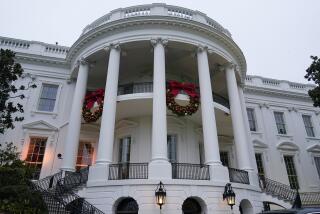White House Christmas Tree Lighting Ceremony Is Dec. 15
- Share via
WASHINGTON — The Christmas tree has its roots firmly planted in the fertile soil of American tradition, nostalgia and the Ellipse south of the White House.
Lighting ceremonies for the living Colorado blue spruce will be Dec. 15, with President and Mrs. Reagan expected to preside for their final time.
Transplanted from Pennsylvania a decade ago, it is known officially as the National Community Christmas Tree and serves as the focus of the annual Pageant of Peace.
In addition to that national Christmas tree, a variety of smaller trees will mark the holiday season in the capital city.
The National Christmas Tree Assn. is maintaining tradition by supplying a tree for the White House. The national grower’s group conducts an annual contest with the winner getting to send a tree to the Executive Mansion.
This year the tree is coming from Snowcrest Tree Farms in Montello, Wis., operated by Irv Daggett.
A score of other trees including those at the Capitol are provided by the U.S. Forest Service.
The centerpiece tree for the Capitol this year will be a 50-foot balsam fir scheduled to be cut Saturday in the Manistee National Forest in Michigan. Lighting of that tree will be Dec. 14, on the West Lawn of the Capitol.
The Forest Service will also provide trees for the Supreme Court, House and Senate dining rooms, Department of Agriculture and a variety of other federal agencies.
The lighting of a national Christmas tree began only with President Coolidge in 1923, but having such a tree in the White House goes back at least to Franklin Pierce in 1856.
Theodore Roosevelt once tried to discourage the use of Christmas trees, fearing that their popularity would deplete the forests.
But the tradition, older than the nation itself, continues.
Indeed, it likely stems from tree-worshiping religions that flourished in central Europe thousands of years ago.
Use of greenery indoors at festival times has been reported from the Roman era, but the first instance of Christmas trees was seen in the 1600s in Germany, coming to this country with the many waves of immigrants from that nation.
In addition to trees, popular seasonal decorations include holly, ivy, mistletoe and, on occasion, nearly any other green plant that can symbolize faith in the coming of spring.
One custom apparently English in origin and now widely popular is kissing under mistletoe. The ancient Druids and Norsemen long considered this plant to have magical qualities, expecting it to cure some diseases, promote fertility, nullify poison and avert misfortune.


